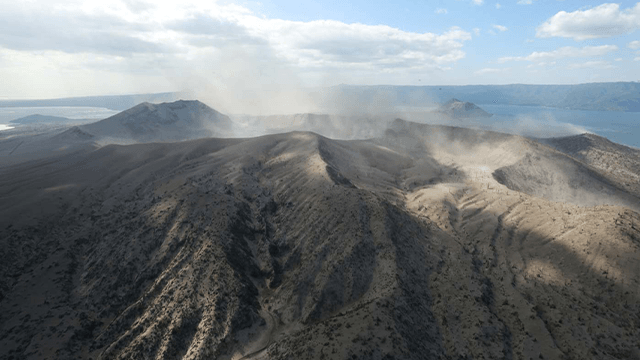SUMMARY
This is AI generated summarization, which may have errors. For context, always refer to the full article.

MANILA, Philippines (UPDATED) – The level of sulfur dioxide (SO2) emission from Taal Volcano in Batangas was lower for the second day, but state volcanologists said a longer trend or pattern must be observed first.
SO2 is a major gas component of magma, and its emission indicates that magma is already at a shallow part of the volcano.
In a briefing on Wednesday morning, January 22, the Philippine Institute of Volcanology and Seismology (Phivolcs) said SO2 emission was measured at an average of 153 tons per day.
The measurement given on Tuesday morning, January 21, had been 344 tons per day. Previous measurements in past days had reached over 4,000 tons per day.
“Hindi porque bumaba ang SO2 ay safe na tayo, dahil puwedeng nababarahan lamang ang mga labasan ng SO2…. So maraming puwedeng maging factors. Kailangan natin makita ‘yung dire-diretsong trend na pababa,” said Maria Antonia Bornas, chief of the Phivolcs Volcano Monitoring and Eruption Prediction Division, in Wednesday’s press briefing.
(Just because SO2 went down doesn’t mean we’re already safe, because it’s possible that the vents where SO2 could be released from are just blocked. So there are many possible factors. We need to see a continuous trend that the emission level is going down.)
Taal is still under Alert Level 4, which means there could be a hazardous eruption “within hours to days.”
In Phivolcs’ 8 am bulletin, it said “activity in the main crater in the past 24 hours has been characterized by weak emission of white steam-laden plumes 50 to 500 meters high.”
Later at 4 pm, it issued an update saying that there have been no ash emissions since 5 am that morning, based on seismic records and visual observations.
But ash blanketing Taal Volcano Island, said Phivolcs, was “remobilized and transported by strong low-level winds” to the towns of Lemery and Agoncillo.
“Reports from several airlines state the presence of remobilized volcanic ash at a height of approximately 5,800 meters (19,000 feet),” added Phivolcs. (READ: Taal Volcano’s 2020 eruption: What we know so far)
Volcanic earthquakes
The “intense” seismic activity, referring to volcanic earthquakes, also continues.
Phivolcs is using two networks to monitor volcanic earthquakes – the Philippine Seismic Network which covers the whole country, and the Taal Volcano Network, which includes small earthquakes undetected by the former.
The Philippine Seismic Network has plotted 725 volcanic earthquakes since 1 pm of January 12, when the Taal unrest began. Of these, 176 were magnitudes 1.2 to 4.1 and were felt at Intensities I to V.
From 5 am on Tuesday until 6 am on Wednesday, there were 6 volcanic earthquakes plotted at magnitudes 1.5 to 2.4, with no felt event.
The Taal Volcano Network, meanwhile, recorded 481 volcanic earthquakes – including 8 low-frequency earthquakes – just in the past 24 hours.
According to the United States Geological Survey, low-frequency earthquakes “are caused by cracks resonating as magma and gases move toward the surface.”
Still threatening
Phivolcs stressed that there must be “total evacuation” of Taal Volcano Island as well as high-risk areas within a 14-kilometer radius from the main crater and “along the Pansipit River Valley where fissuring has been observed.” (WATCH: Fishermen risk lives for catch around restive Taal Volcano)
Fissures or cracks had appeared in parts of Batangas province, particularly in the towns of Lemery, Agoncillo, Talisay, and San Nicolas, which are all high-risk areas. (WATCH: Gov’t to force residents out of homes in Taal Volcano danger zone)
If a hazardous eruption occurs, Alert Level 5 – the highest – would be raised. (READ: TIMELINE: Taal Volcano eruptions since 1572)
But the status might be downgraded to Alert Level 3 – that is, if all parameters being monitored by Phivolcs go down for an extended period of time.
“Kung patuloy po ang downtrend ng mga monitoring parameters, ibababa po naman natin ang alert level matapos masiguro na ang probabilities for an eruption ay mababa na,” Bornas said.
(If the downtrend in the monitoring parameters continues, we would downgrade the alert level once we make sure that the probabilities for an eruption are already low.)
Note, however, that Alert Level 3 would still mean a hazardous eruption is possible “within days to weeks.”
The long, uncertain wait is taking its toll on displaced residents. There are 39,052 families or 148,987 persons in evacuation centers, according to the National Disaster Risk Reduction and Management Council. (WATCH: Evacuees getting anxious a week since they fled homes near Taal Volcano)
Both Batangas and the neighboring province of Cavite are under a state of calamity. (READ: Robredo returns to Batangas, Cavite to give more aid to Taal evacuees) – Rappler.com
Add a comment
How does this make you feel?
There are no comments yet. Add your comment to start the conversation.